The photos in this post are of Fr Ashley Caldow’s ordination, in Bendigo’s Sacred Heart Cathedral, on 14 September this year.
The photos are mostly from the Catholic Community of Bl John Henry Newman and Michael Daniel’s Flickr page. There is one exception: Carmel Righetti took the photo of me laying my hands on Ashley’s head.
Seminarians in choir
“In choir” doesn’t mean these guys will lead the singing. It means they are dressed in soutane and surplice, they process in and out with the clergy and altar servers, and they sit in a designated place. Critics of this custom say it is clerical and sets the seminarians apart; proponents — and I am one! — say that it’s good witness to the vitality of the priestly vocation. It can only have a positive impact on the young man who is sitting at the back of the church, moved by the ordination he is attending, but wrestling with the possibility that God might be calling him to be a priest too.
Apart from that, ordinations are a great highlight in the seminary year. Seven or so years at the seminary is a tough slog. There were times when I was discouraged, and I contemplated leaving. Ordinations are an occasion for seminarians to renew their assent to the priestly vocation, and share in their brothers’ joy.
The two seminarians at the head of this procession will be ordained deacons in the next few weeks. Pray for them!
The priestly ordinand
This photo shows then-Deacon Paul Nulley (he was ordained a priest last night) processing in, like the other seminarians, “in choir.” You might just make out a red stole hanging from his left arm. He will wear the diaconal stole during the rite of communion, in the same style that Deacon Ashley Caldow is wearing his.
Ashley, you can see, is not “in choir.” He is vested in soutane, alb and stole. The alb belongs to the late Fr Les Ring, who was Ashley’s parish priest when he was younger. This gives you a better view of the alb:
Incidentally, at an ordination mass the clergy are usually vested in white or gold. But Fr Ashley was ordained on the Feast of the Exaltation of the Holy Cross, so the vestments were red.
Presentation of the candidate
After the Gospel, the seminary rector, Fr Brendan Lane, presented Ashley to the bishop. Bishop Tomlinson asked, “Do you judge him to be worthy?”
Fr Brendan replied, “After inquiry among the people of Christ and upon recommendation of those concerned with his training, I testify that he has been found worthy.”
The bishop then declared his intention to ordain Ashley, and the people replied, “Thanks be to God.” That’s the cue for everyone to applaud. I’ve heard it said that in ancient times, if people did not applaud or otherwise express their consent, the ordination didn’t go ahead!
The bishop preaches
After this, the bishop preaches. Here you can see that Bishop Tomlinson is preaching from a chair placed in front of the altar. The bishop could also preach from the ambo, where the Gospel was proclaimed and where priests usually preach, or he could preach from his cathedra, which is the ordinary place for a bishop to preach (ex cathedra).
I guess Bishop Tomlinson is preaching from here because this is where he will minister the sacrament of ordination. It is closer to the people, and affords them a better view of the rite. This is also the practice in Melbourne and Ballarat.
The ordinand is examined
After the homily, the ordinand resumes his place standing before the bishop who asks him a series of questions. The ordinand resolves to devote himself to the priestly ministry “as a conscientious fellow worker with the bishop.” He resolves to celebrate the sacraments “faithfully and religiously.” He resolves to teach and preach “worthily and wisely.” He resolves to consecrate his life to God, and unite himself with Christ the High Priest.
Then the ordinand approaches the bishop, kneels before him, and joins his hands in fealty. The bishop clasps his hands and asks him, “Do you promise respect and obedience to me and my successors?”
Every time Christians kneel and join their hands in pray, we evoke this posture of obedience. It recalls our Lord’s prayer in the Garden of Gethsemane: “Father, if you are willing, remove this cup from me. Nevertheless, not my will, but yours, be done.” (Lk 22:42)
The litany of saints
During the litany of saints, everyone in the church kneels towards the altar, and prays for the ordinand. The ordinand himself lies prostrate before the altar.
This always moved me when I was a seminarian, and it moves me still.
The laying of hands
The bishop lays his hands on the ordinand in silence.
All the priests present — me too! — do the same. The act of the priests isn’t sacramental. Their imposition of hands merely makes more forceful the outward sign of power being conferred through the bishop’s sacramental action.
Consecration
The bishop stretches out both hands and speaks or sings the prayer of consecration. At Ashley’s ordination, the priests present formed a semi-circle behind the bishop, raised their right hand and prayed in silence.
I’ve never seen this happen before, but apparently it was the universal practice in the pre-conciliar rite of ordination. I guess it’s one of those things that some dioceses have held on to.
Anointing
The bishop anoints the new priest’s hands with the oil of sacred chrism. This oil is also used at baptism, confirmation, and in the coronation of Christian monarchs.
Here Fr Ashley wipes the chrism from his hands. Since the oil is perfumed, the cloth becomes perfumed. The day after I was ordained, at the conclusion of my Mass of Thanksgiving, I presented the purificator I had used to my mother.
The mother of a priest is often buried with the cloth wrapped around her hands. Then — this is a superstition, but a pious and edifying one, if not taken literally! — when she stands before the Lord, her hands smell of chrism, and our Lord recognises her as the mother of a priest.
The priest is vested
A priest assists the newly ordained to be vested. Fr Ashley asked Fr Michael McAffrey FSSP, from Adelaide, to assist him. As you can see, Fr Ashley was vested in a Roman chasuble, also known as a “fiddle back” chasuble.
Many people view this design as “pre-conciliar” and associate it with the Traditional Latin Mass. The Gothic chasuble, which is much more commonly used, is viewed as its modern counterpart. In fact, though, the Gothic design is more ancient than the Roman design. Both designs are perfectly legitimate, and may be used at either form of the Roman Rite.
Presentation of gifts
The bishop presents the new priest with the gifts which will be offered for sacrifice. An ordinand will often receive an ordination gift of a new chalice and paten, so these are used in this rite. The paten is loaded with bread and the chalice is filled with wine and water.
Having received the gifts for the sacrifice, the gifts are moved to the altar where they are offered at the same Mass.
The sign of peace
The rite of ordination concludes with the sign of peace. The bishop is the first to express his fraternity with the new priest.
And then Fr Ashley’s sacerdotal brothers are able to do the same.
Consecration to our Lady
At the conclusion of his ordination Mass, Fr Ashley consecrated himself to our Lady and entrusted his priesthood to her. This is an entirely optional addition, and quite distinct from the ordination. After all, the sacrament itself already consecrates a priest to the Holy Trinity.
Speaking personally, though, I think this is a beautiful custom. I did the same, not at the conclusion of my ordination Mass, but at the conclusion of my Mass of Thanksgiving the next day. I keep the text of my consecration and entrustment on my desk, and I make it a daily habit to to read it and interiorly renew it.
Priestly blessings
It’s an old and venerable custom to ask a newly ordained priest for his blessing. (“Newly-ordained,” in this context, applies for 18 months after the ordination!) You can say, quite simply, “Father, your blessing,” and if you’re able, you kneel before him. (He won’t mind whether you stand or kneel.) The priest then gives his blessing.
From the look of this photo, my guess is that Fr Ashley is giving the traditional blessing of the newly ordained, which is very lengthy and easier to read than to memorise!
At the conclusion of the blessing, many people kiss the palms of the priest’s hands. These hands, after all, were recently anointed with the sacred chrism, and the same hands handle the Body and Blood of Christ and minister the sacraments. In my experience, half the people kissed my hands, and half didn’t, so don’t feel pressured either way. Again speaking personally, I think this is a beautiful custom.
So, if you run into Fr James Kerr, or Fr Ashley Caldow, or Fr Paul Nulley, or Fr Siju Mukakejakayil in the next 18 months, ask them for a blessing!

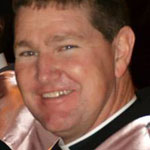
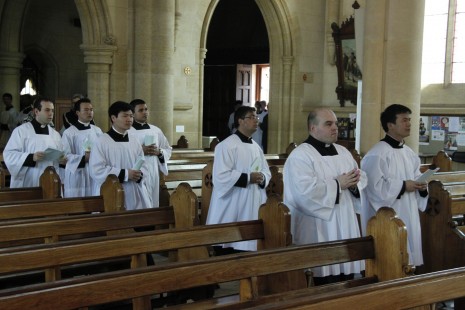
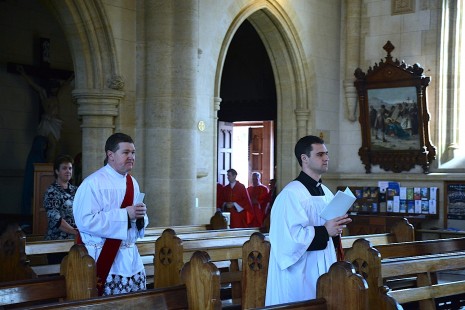
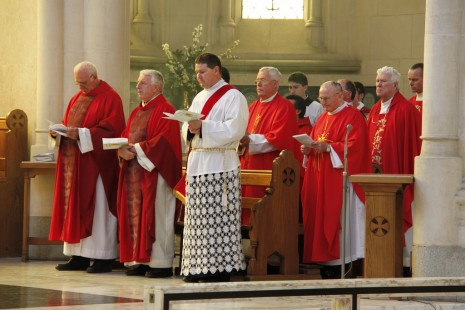
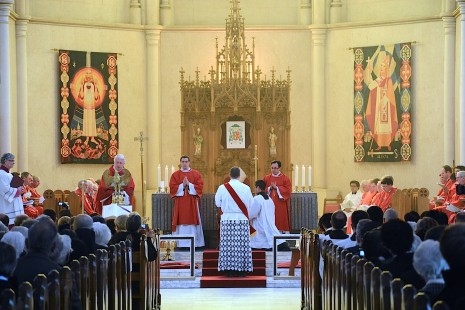
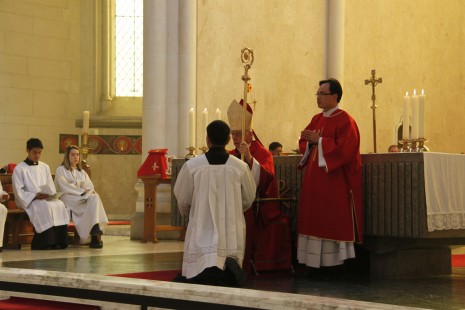
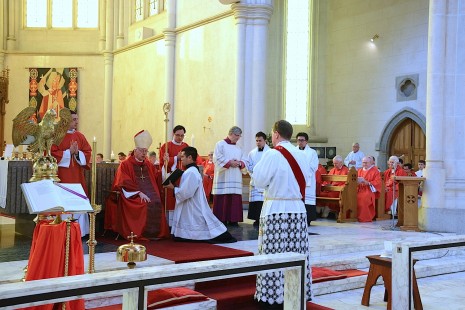
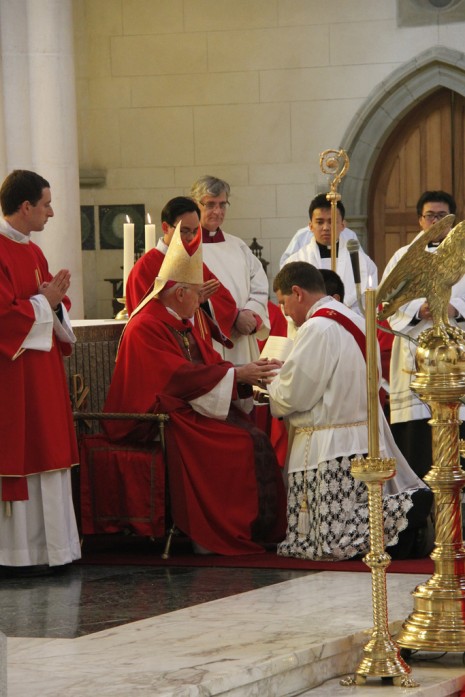
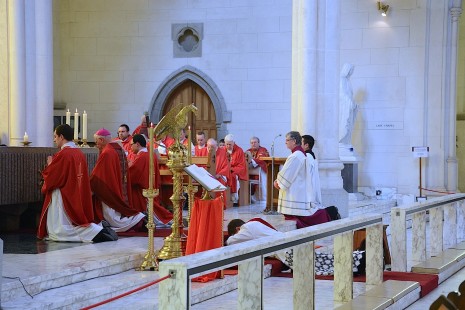
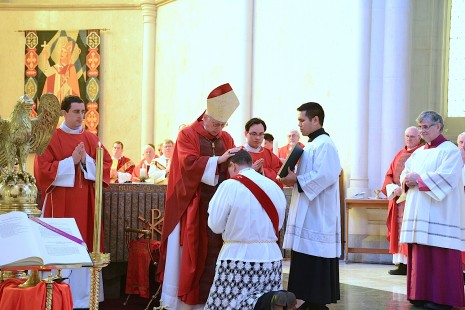
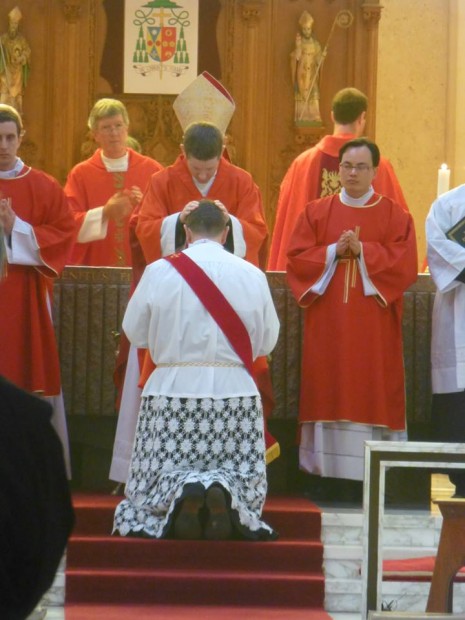
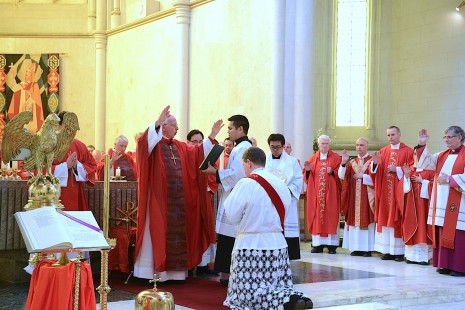
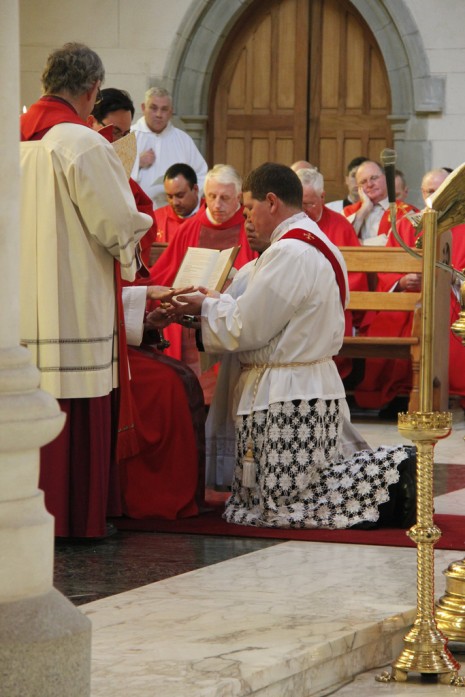
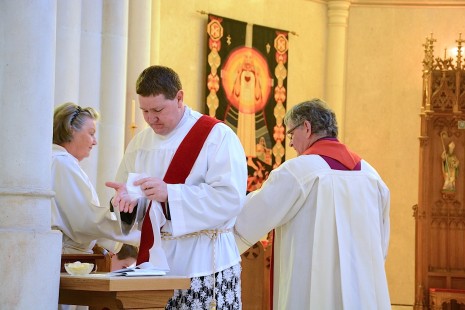
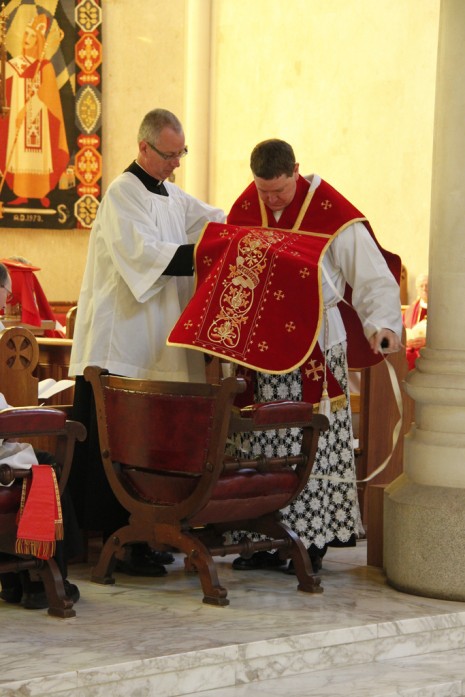
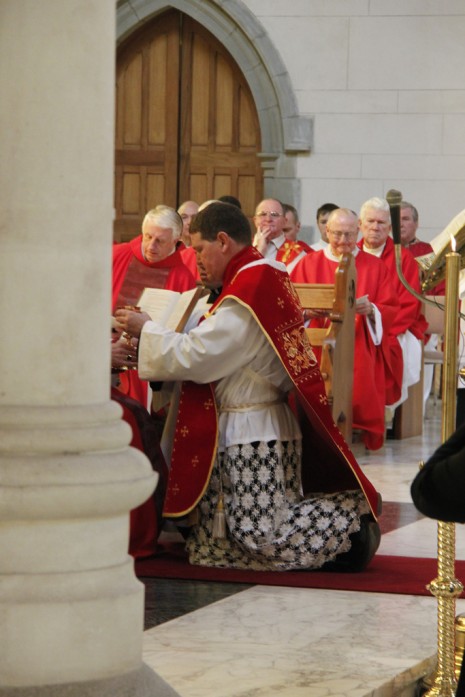
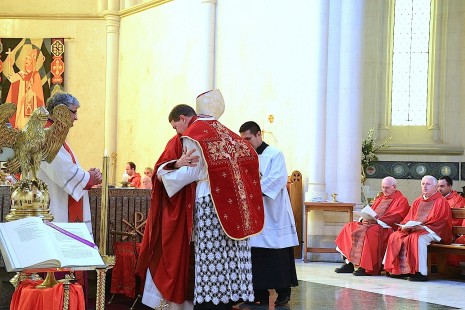
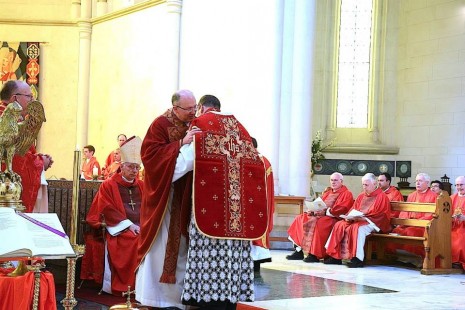
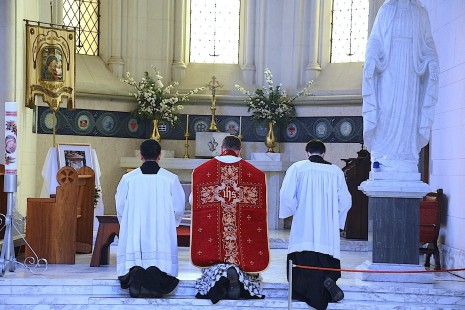
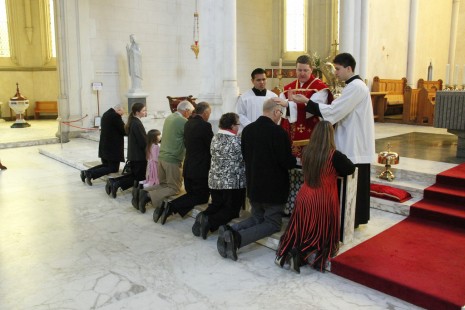

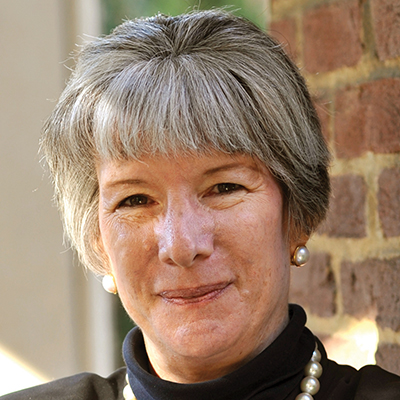


I felt like I was at yours and James Kerr’s ordinations again!
I will ask “Your Blessing Father” and kiss his palms when James celebrates Mass here in October.
As usual your offering is interesting, and this one quite touching. I was moved by the pious reflection on Holy Chrism and the priest’s mother. John, we’re all so very glad you didn’t “leave”.
I’m glad too Chris! 🙂
Fr John – thank you so much for this lovely exposition of the rite and photos of Fr Caldow’s ordination. My amateur android shots were full of people’s backs and heads!
Also beaut to catch up with you briefly at Fr Nulley’s ordination this weekend, here on my own patch in Canberra.
The worship of God, what we all are created for, and the priest is ordained to enable the people to do, in their daily lives what Christ did on the Cross and in His Resurrection, offer a perfect sacrifice to God.
Your reflections and teachings are consoling in that they show me that what was clouded for so long, is now once again, out in the light to inspire us, particularly me, a poor and very ignorant priest, to follow that number one vocation we all share, priest and people alike, to adore God and to be ever grateful to the Church for embodying the daily ways to follow Christ.
Amen Fr Mick!
We have just had an ordination here in Perth on Friday evening. Fr Brennan Sia. His face was shining with joy which covered every one around him. Thanks be to God. To Him be Glory and Praise forever.
Do you know, Rosemary, I don’t think I’ve ever met Fr Brennan. That’s the tyranny of distance I guess! All the seminarians on the eastern seaboard meet up regularly for a national soccer tournament. But Perth is so far away, and the travel costs prohibitive.
Still, I knew of his ordination via the ACCC‘s newsletter, and I’ll keep an eye for the story in the next edition of The Record. Thanks be to God, indeed!
I am greatly looking forward to attending Fr Paul’s first Mass at my parish, receiving his blessing and kissing his hands. I fear I will burst into tears! It is wonderful to have what is a relative abundance of ordinations of such wonderful young men!. God bless you all!
The big question is who decides to put new priest vestment on! Does the bishop make the call or do you make the call? Also when new ordinate priest allow to stop making mistakes is it a month or 18 months. I am sure people don’t realise. Does it feel funny when you back to St. Patrick’s Catheral oh I am a priest now I better get things ready. I can’t just sit at the back with the bells anymore!